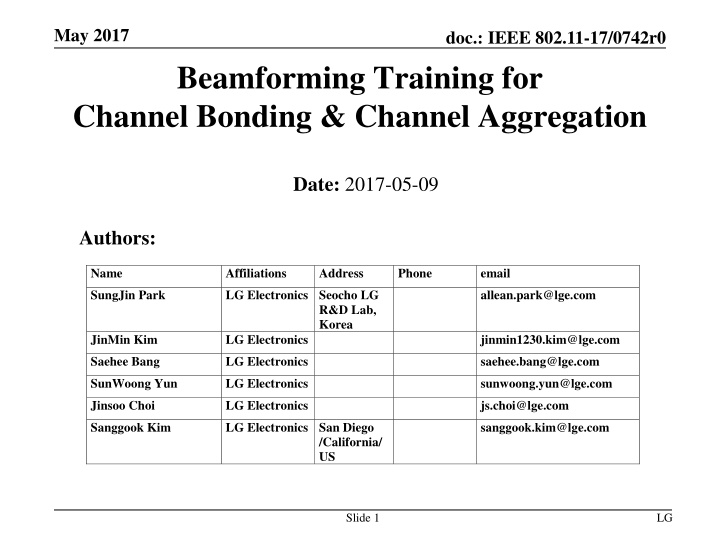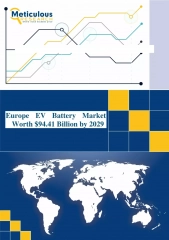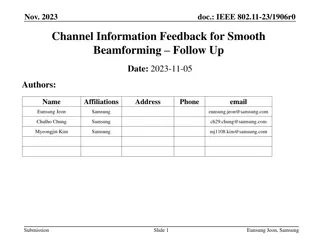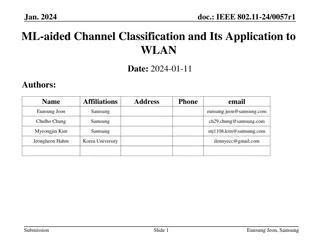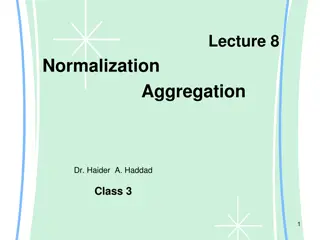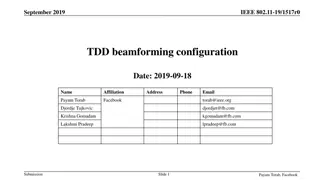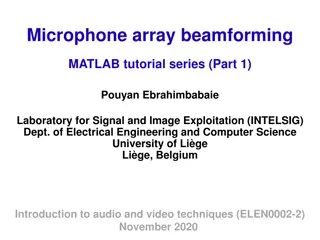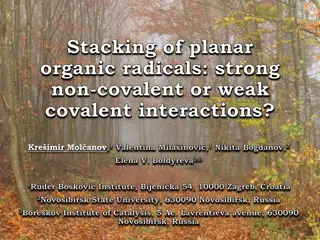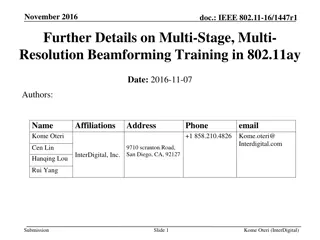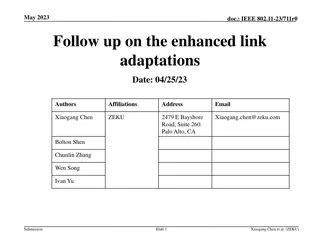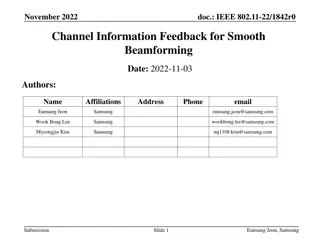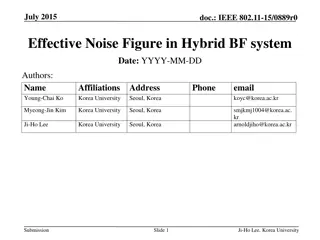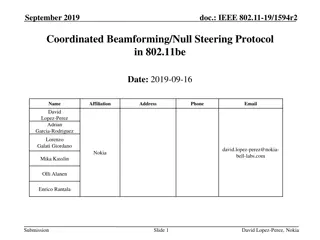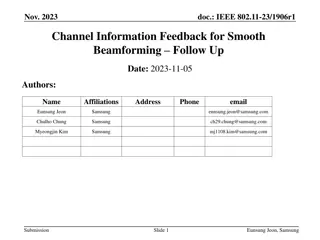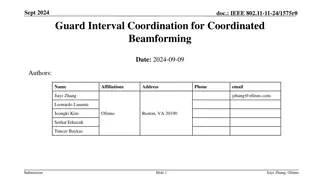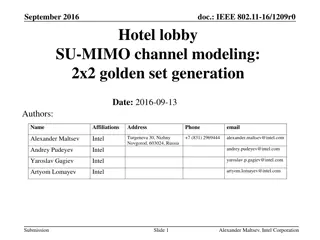Beamforming Training for Channel Bonding & Channel Aggregation
This document discusses the beamforming training process for channel bonding and channel aggregation in IEEE 802.11 standards. It covers the different scenarios where beam refinement is required and proposes PPDU formats for training beamforming. The document outlines the procedures for refining the beam over bonded and aggregated channels based on initiator and responder interactions.
Download Presentation

Please find below an Image/Link to download the presentation.
The content on the website is provided AS IS for your information and personal use only. It may not be sold, licensed, or shared on other websites without obtaining consent from the author.If you encounter any issues during the download, it is possible that the publisher has removed the file from their server.
You are allowed to download the files provided on this website for personal or commercial use, subject to the condition that they are used lawfully. All files are the property of their respective owners.
The content on the website is provided AS IS for your information and personal use only. It may not be sold, licensed, or shared on other websites without obtaining consent from the author.
E N D
Presentation Transcript
May 2017 doc.: IEEE 802.11-17/0742r0 Beamforming Training for Channel Bonding & Channel Aggregation Date: 2017-05-09 Authors: Name Affiliations Address Phone email SungJin Park LG Electronics Seocho LG allean.park@lge.com R&D Lab, Korea JinMin Kim LG Electronics jinmin1230.kim@lge.com Saehee Bang LG Electronics saehee.bang@lge.com SunWoong Yun LG Electronics sunwoong.yun@lge.com Jinsoo Choi LG Electronics js.choi@lge.com Sanggook Kim LG Electronics San Diego sanggook.kim@lge.com /California/ US Slide 1 LG
May 2017 doc.: IEEE 802.11-17/0742r0 Introduction The EDMG STA can perform the BF training for CB & CA by using BRP packets. The BRP PPDU can be different depending on the following cases. Case1: an initiator has trained BF on a bonded and aggregated channel with a responder. Case2: an initiator has not trained BF on a bonded and aggregated channel with a responder. Slide 2 LG
May 2017 doc.: IEEE 802.11-17/0742r0 Existing BRP PPDU format (BF on a bonded channel was trained) If an initiator has trained BF on a bonded channel with a responder, the initiator and responder can transmit the following PPDU format in order to refine the beam over a bonded channel. The duplicate part of PPDU can be decoded through the primary channel The bonded part of PPDU can be decoded through a bonded channel This training part of PPDU conducts beam refinement for a bonded channel. This PPDU format is suitable for beam refinement if the best sector over a bonded channel is already known. *Sector m: the best sector from previous BF results over a bonded channel Slide 3 LG
May 2017 doc.: IEEE 802.11-17/0742r0 Proposed BRP PPDU format (BF on a bonded channel was not trained) If an initiator has not trained BF on a bonded channel with a responder, the following PPDU format is suitable for initiating BF training for CB. The duplicate part of PPDU can be decoded through the primary channel This training part of PPDU conducts BF training for a bonded channel Until conducting this part, the best sector for a bonded channel cannot be founded. This PPDU format should be allowed in order to achieve BF training for CB. *Sector n: the best sector from previous SLS results Slide 4 LG
May 2017 doc.: IEEE 802.11-17/0742r0 Proposed BRP PPDU format (BF on a aggregated channel was not trained) If an initiator has not trained BF on an aggregated channel with a responder, the following PPDU format is suitable for initiating BF training for CA. The duplicate part of PPDU can be decoded through the primary channel This training part of PPDU conducts BF training for an aggregated channel Until conducting this part, the best sector for an aggregated channel cannot be founded. This PPDU format should be allowed in order to achieve BF training for CA. *Sector n: the best sector from previous SLS results Slide 5 LG
May 2017 doc.: IEEE 802.11-17/0742r0 Proposed Aggregation field in EDMG control mode In EDMG control mode, the Aggregation field is not defined in EDMG Header-A. To indicate whether TRN format in EDMG control mode PPDU is bonded or aggregated, we propose Aggregation field in EDMG Header-A. Table 15 - EDMG Header-A2 subfield definition Field Number of bits Start bit Description Aggregation 1 0 If this field set to 0, the BW field specifies that the TRN field of the PPDU is appended on a 2.16 GHz, 4.32 GHz, 6.48 GHz or 8.64 GHz channel. If this field set to 1, the BW field specifies a 2.16+2.16 GHz or 4.32+4.32 GHz channel. This field is reserved if the value of the EDMG TRN Length field is 0. Set to 0 by the transmitter and ignored by the receiver. Header Check sequence. Calculation of the header check sequence is defined in 20.3.7. Reserved CRC 7 16 1 8 Slide 6 LG
May 2017 doc.: IEEE 802.11-17/0742r0 Examples of EDMG control mode PPDUs for BF training for CB & CA BW field set to 6.48GHz Aggregation field set to 0 (6.48GHz channel) BW field set to 4.32GHz Aggregation field set to 1 (2.16+2.16GHz channel) BW field set to 8.64GHz Aggregation field set to 1 (4.32+4.32GHz channel) Slide 7 LG
May 2017 doc.: IEEE 802.11-17/0742r0 Conclusion We proposed that EDMG BRP packet is transmitted by the EDMG control mode PPDU in order to perform BF for CB & CA. Slide 8 LG
May 2017 doc.: IEEE 802.11-17/0742r0 SP/Motion Do you agree to include the text for the beamforming training for channel bonding and channel aggregation proposed in (11-17-0743-00- 00ay-Beamforming Training for CB & CA) to the draft? Slide 9 LG
